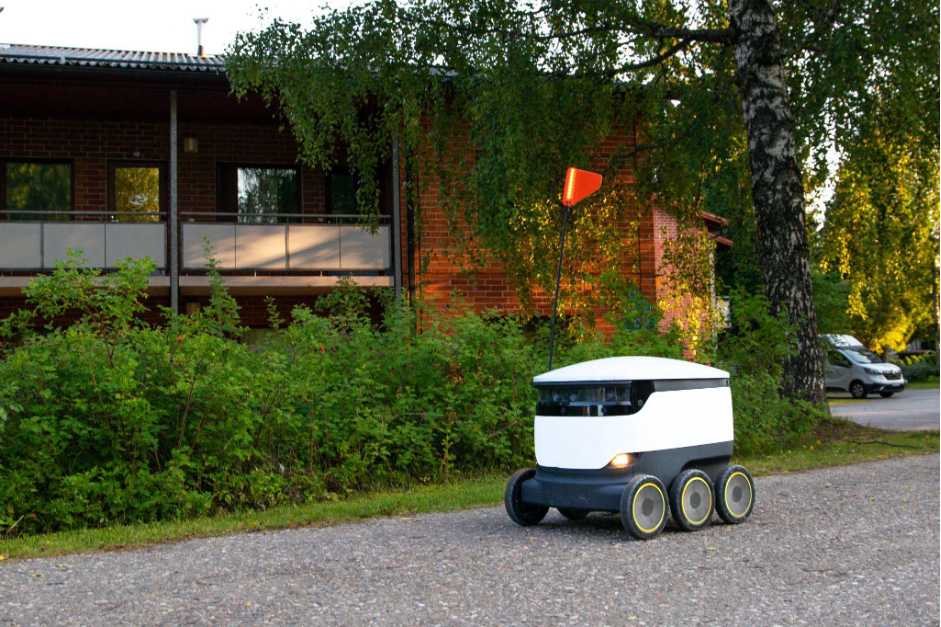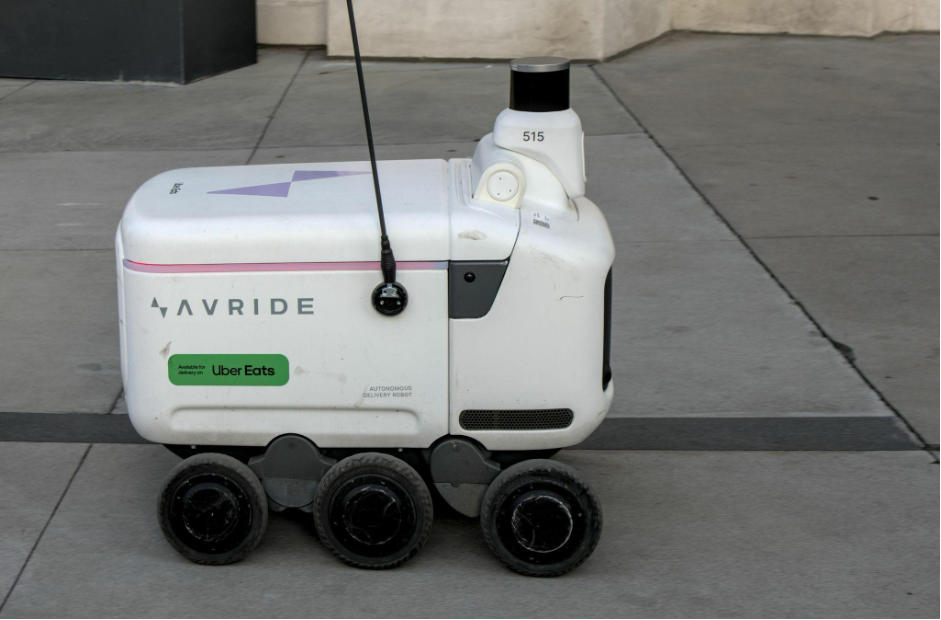Food delivery robot?- A Glimpse into the Future
It was a typical lunch break in New York City. Two colleagues wanted to have their lunch at NYC park, and they wanted to sit quietly and have their lunch away from the busy world, and to take some time off work. One of them ordered their lunch using ESIMUSA.com, which had seamless connectivity for fast, secure, and affordable data services. They placed their order via an app, just like how millions of people do every day. The two colleagues were waiting like any other people who would wait for delivery, in the huge NYC park, spotting a delivery guy was very difficult. But that day, even when the app sent a notification that the food delivery had arrived, no one was there except for a small robot with four wheels for delivery waiting outside. Once they pressed the button in the app, the robot opened and delivered the ordered food. The colleagues were overwhelmed by what felt like a scene from science fiction. In the 21st century, robots delivering lunch in a busy New York City are no longer science fiction but a new urban reality. Deliveries like these are now operating with Uber Eats in many cities in the US. Uber Eats introduces Uber delivery robots in Jersey City, New Jersey, according to CBS News.
How does a food delivery robot work?

A food delivery robot is a robot that brings food from a grocery store or restaurant to the customer’s home or office. The robot uses GPS navigation, cameras, and sensors to discover the best ways to avoid obstacles and get to the right place, to deliver meals quickly. The operations are reported to the customers through an app that allows them to track their orders.
The design of the food delivery robot is typically compact, often smaller than a large cooler box, secured with four to six rolling wheels for easy movement over the sidewalks and around obstructions. The body of the robot is made out of secure, insulated compartments that keep food at the right temperature during transit, and sensors and cameras are embedded for navigation and safety.
These delivery robots can be effectively used in universities, urban areas, or tech-forward cities where robots can easily move around sidewalks and in public spaces, and also in indoor settings like restaurants, hotels, and even buildings where elders live together.
Behind the Scenes: How Uber Eats’ Food Delivery Robots Operate
Step-by-step overview

- Step 1: Place your order using the Uber Eats app
You can opt for food delivery by a food delivery robot. - Step 2: The Robot receives a delivery Route.
Once selected, the robot is assigned the delivery, and the restaurant will also be notified that the food delivery robot will be picking the order, not a human. - Step 3: Navigation with GPS, Cameras, and Sensors.
The robot uses a combination of sensors, advanced GPS, cameras, and LIDAR to chart an optimal path. It cautiously moves around sidewalks, avoids everything in its way, and follows the traffic regulations it has been given to make sure the trip goes smoothly. - Step 4: Arrival and Customer notification.
As the robot approaches the delivery location, the customer receives an app notification and can track the Uber robot delivery’s live location, like any food delivery service. - Step 5: Compartment access via App or Code
Once the Uber Eats delivery robot arrives, the customers are given a notification to unlock the compartment that holds the food. This ensures the safe delivery of food to the intended user. Uber Eats not only offers Robot delivery service, but they still use humans for food delivery services, as these robots need a person to collect the food, they cannot drop off at the destination location. Hence, Uber Eats has incorporated a hybrid model for their food delivery services.
Key technologies involved
- GPS & Mapping: For precise, real-time navigation from source to destination
- AI & Mapping learning: Robots use algorithms to learn safe, quicker, and efficient routes, and they also make real-time decisions to avoid obstacles or closed sidewalks
- Obstacle Avoidance: Robots can see and avoid people, cars, and other things that get in their way thanks to a lot of sensors, cameras, and LIDAR
- 4G/5G/eSIM Connectivity: Robots rely on constant, robust internet connectivity that often relies on eSIM technology to update the router, send notifications, and also to stay in contact with Uber’s central system. This links the robot’s reliability and real-time performance directly to modern mobile technologies.
This ecosystem enables the automatic, quick, and safe delivery of food. What once seemed like something from the future is now a common convenience in many urban areas
Advantages of Robot Food Delivery
- Contactless delivery: In times like COVID-19, when it was high priority for hygiene and minimizing human contact was essential, these food delivery robot can step in to enable fully contactless drop-offs.
- 24/7 Operation: Unlike human couriers, robot delivery is uninterrupted by fatigue, breaks, or any working hour restrictions.
- Lower delivery costs: Food delivery robot do not require wages, tips, or breaks, which in turn reduces labour expenses significantly.
- Eco-friendly, as most of the delivery robots are operated by electric power.
- Memorable and innovative experience: The experience of food being delivered by these robots can be memorable, as if they are straight from science fiction movies.
All of these things together make robotic food delivery a game-changing innovation that makes life easier, saves money, and helps both public health and the environment.
Challenges and limitations of Food delivery robots
- Inability to handle stairs or complex building entries: Most of the food delivery robots are designed for sidewalk navigation, not for buildings that have multiple floors. Hence, they are restricted to the ground floor.
- Slower in speed compared to bike couriers. This can be improved in the future.
- Battery life and charging time are a serious limitation. Hence far location delivery is not possible.
- Weather sensitivity is another serious constraint; adverse weather conditions such as heavy rain, snow, or ice are a serious limitation.
- Need for human monitoring and Support: despite their autonomous nature, these robots often still require human operators to monitor their journey, Troubleshoot if any problem arises, or if any technical issues arise, they need human assistance.
- Legal and Sidewalk Space Regulations, as robots are often constrained by a patchwork of local laws.
In short, food delivery robots have a lot of potential, but their existing technology, legal, operational, and social issues need to be fixed through better technology, better rules, and more public involvement so that they may be used safely and efficiently by a lot of people.
What’s Next for Food Delivery Robots? AI, Drones, and Beyond
The future of food delivery with robots is evolving rapidly, driven by advanced AI technologies, connectivity, and urban infrastructure. As Artificial Intelligence is getting smarter, these food delivery robots with machine learning capabilities can become smarter than their current capabilities. Robots will be able to navigate around complex environments and deliver food faster than now. Emerging concepts like drone-robot hybrid systems could take ground delivery to aerial delivery. Many of the companies have already trialed drone-based, quicker delivery for their premium clients, maybe it’s not too far for the food delivery industry to use aerial technologies. With the increase in urbanisation and desire for convenience, robotic delivery has the potential to become the new normal in the coming days. As rules and regulations change, people trust robots more; robot delivery could become a subtle but important aspect of life in modern cities, changing the way we obtain our food one trip at a time.
Human vs. Robot: Will Robots Replace Delivery Drivers?
While the food delivery robot is growing rapidly, it is unlikely that robots will fully replace human delivery drivers, at least not anytime soon. As of today, robots are best suited for delivery services on short and predictable routes. The robots still require human monitoring for effective operations as they struggle to deliver at drop-off with complex infrastructure, or manage customer service-related issues, as it still requires a human touch to mitigate these kinds of issues. Rather than eliminating jobs, they can ease the workload during busy hours to cover late-night or low-demand shifts. Furthermore, most of the robots need constant human monitoring or remote support for their operational efficiency. In the future, we are more likely to see a hybrid system that improves efficiency while still valuing the human workforce.
Conclusion: A Bite of the Future
Food delivery is no longer science fiction but a reality in most urban lives. These autonomous machines are changing the way we think about convenience, speed, and technology. From rolling sidewalks to navigating university campuses, the food delivery robots are nothing more than technological innovation. Though they won’t replace human delivery drivers, but are almost taking key roles, making them replaceable. As these technologies continue to evolve, staying connected is more important than ever. With a reliable solution like ESIMWORLD.net, you can have seamless access to food delivery services anytime, anywhere, whether your order arrives by bike, car, or a robot on wheels. The food delivery robots. Powered by AI and connected by eSIM technology, food delivery is becoming faster, sustainable, and more reliable than ever.

